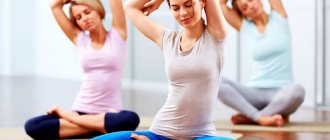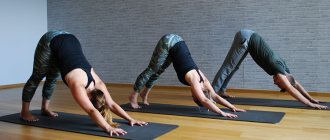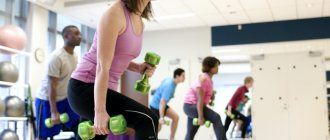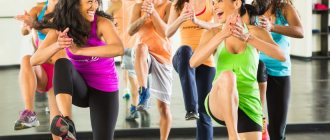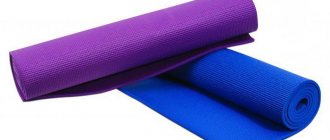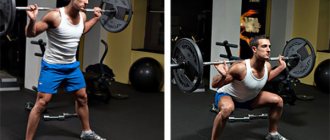As we know, one of the main characteristics of yoga is staticity, that is, a minimum of movement, positions are held motionless for some time. This practice is not suitable for everyone. Some, mostly young, very energetic people, prefer something more active. But this is not at all a reason to give up yoga, because there is a direction that combines classical yoga techniques with dynamics. This direction is called fitness yoga.
- What is fitness-yoga and the difference from aerobics
- A set of fitness yoga exercises
- Cycle: warrior pose I (Virabhadrasana I) + warrior pose III (Virabhadrasana III)
- Cycle: downward looking dog (Adho Mukha Svanasana) + upward looking dog (Urdhva Mukha Svanasana)
- Cycle: extended arm plank (Kumbhakasana) + side plank (Vasishthasana)
- Cycle: full boat pose (Paripurna Navasana) + half boat pose (Ardha Navasana)
- Abdominal Twist Pose (Jathara Parivartanasana)
- Video: The benefits of fitness yoga and a lesson for beginners
How does fitness yoga differ from classical yoga and fitness?
Fitness yoga has some differences from classical yoga, as well as from fitness. To practice this type of yoga, you should choose a well-known practicing trainer. Many experts may shy away from yoga a little and are moving this practice into a popular fitness direction. This is fundamentally wrong, since it still implies practical work, the same as in the classic version.
In order to keep your body in good shape, you need to do yoga every day, and you can do fitness yoga only two to three times a week, maintaining your mood with periodic meditation. It involves mainly static loads. The main emphasis is placed on physical practices, including breathing work. The difference from classical yoga is that in the classical version more importance is given to the spiritual world of a person, his consciousness and awareness of his own “I”.
Fitness yoga can be divided into groups according to level of preparedness. Usually people do not strive to move to a higher level of training, since even the initial stage involves the formation and formation of a strong muscle corset, correct posture and good health.
Fitness yoga excludes intense cardio training. It is aimed mainly at developing coordination of movements, strength and endurance.
Fly in the ointment: possible harm
Flaw
Despite the fact that fitness yoga has absorbed all the best from both directions, it also has a significant drawback. Asanas, traditionally performed slowly, are given here at an accelerated pace. Despite the simplicity of the technique, rhythm increases the risk of injury. This makes referral unavailable for certain diseases. Stretching exercises affect not only muscles and ligaments, but also affect internal organs. If there are problems with them, most likely you will have to choose other types of physical activity.
Contraindications
Contraindications for fitness yoga:
- injuries of varying complexity to any part of the body, from a minor bruise with a hematoma to a fracture;
- serious problems with the spine: hernia, sciatica, kyphosis, myositis, radiculitis, spondylosis, chondrosis;
- joint diseases: arthrosis, arthritis, arthralgia, bursitis, gout, osteochondrosis, periarthritis;
- disorders of the heart: ischemic heart disease, hypertension, myocarditis, endocarditis, pericarditis, defects;
- any pain: headache, menstrual, dental;
- obesity of degree II or more (you will first have to lose weight through diet);
- increased body temperature;
- exacerbation of any diseases (infectious and chronic).
Contraindications are not absolute. If you have one of the above diagnoses and have a great desire to enroll in this particular direction, you need to contact a specialized specialist and consult. He will give recommendations on what type of physical activity and at what pace is allowed for this disease. If, for example, radiculitis is seasonal, and osteochondrosis is at an early stage, training is quite possible and can even improve your well-being.
Consequences
If you neglect contraindications and the correct technique for performing exercises, you can significantly harm your health. A frivolous attitude to exercise can lead to such unpleasant consequences as:
- exacerbation of existing diseases;
- increased blood pressure;
- headache;
- long-term, continuous soreness;
- sprained ligaments or muscles;
- muscle fiber rupture;
- complete muscle separation.
If after 2-3 sessions the pain does not go away and your health does not improve, you should stop training and seek help from a doctor.
During pregnancy
Separately, it is worth mentioning fitness yoga for pregnant women. You can find many different interpretations on this issue in the sources. Some argue that this direction prepares the internal organs of the expectant mother for the upcoming birth and helps reduce pain subsequently. Others warn that classes can be extremely dangerous for the baby's intrauterine development. As is usually the case, the truth is somewhere in the middle.
Fitness yoga can be practiced during pregnancy if:
- the woman has previously practiced sports or yoga, and her body is prepared to perform asanas;
- permission for this has been obtained from the gynecologist monitoring the pregnancy and the fitness instructor leading the classes;
- a fitness yoga group is being recruited specifically for pregnant women (the exercises are adapted and simplified as much as possible);
- pregnancy proceeds without complications.
In all other cases, fitness yoga is not recommended during pregnancy. Especially at home, without an instructor or outside help. This can lead to placental abruption, miscarriage, intrauterine fetal hypoxia, or premature birth.
Benefits of Fitness Yoga
Thanks to properly selected exercises, you can achieve very significant results within a month after starting classes. Your well-being and overall appearance improve, your figure tightens and your body becomes more flexible and resilient.
Pros:
- Burns calories.
- Tightens the body.
- Improves mood.
- Improves the functioning of internal organs.
- Increases immunity.
- Helps cope with pain.
- Relieves joint and back pain.
- Helps you learn to maintain balance and equilibrium.
- Strengthens the muscle corset.
- Improves posture.
There are many more benefits that fitness yoga undoubtedly brings. It is even indicated for pregnant women, if you follow some individual recommendations.
Who is it suitable for?
Fitness yoga can be mastered by beginners and those who already have significant sports experience.
Classes can be easily adjusted to individual levels of stress, therefore reducing the risk of injury or discomfort. This direction will be useful for people leading a sedentary lifestyle. For those who sit at their desk all day. And also if a person has health restrictions regarding dynamic or strength exercises.
With constant practice, your appearance, well-being and mood significantly improve. The body becomes more flexible, resilient, and physical activity increases.
Fitness yoga helps you lose weight
Fitness yoga for weight loss is very often practiced in modern fitness centers and sports clubs. Unlike classes in the gym, fitness yoga involves group classes. The group can reach 20 people. This means that when a person comes to group training, he will subconsciously feel the urge to compete, and accordingly, his results in achieving his goal of ideal weight will grow very quickly.
There are people who do not like too slow and calm workouts, such as classical or Pilates. This type of practice is perfect for such individuals; it combines both cardio and static exercises.
This practice helps optimize the functioning of internal organs not only through regular and correct exercises, but also through properly organized breathing exercises performed during training. Everyone knows that proper deep breathing saturates cells with oxygen and regulates the functioning of the thyroid gland. This means that proper breathing in combination with exercise gives positive results in the fight against weight loss.
Yoga in dance is a special type of yoga.
Today, a new technique has appeared in fitness clubs and yoga centers that combines dance and yoga.
Yoga dancing is a kind of dynamic meditation and relaxation, which represents the fusion of two systems. These systems complement each other, creating a special sign language; in other words, asanas are combined into a dance.
Yoga in dance is suitable for people with a frantic pace of life, who have accumulated fatigue and irritability; this type of exercise helps many to put their inner world in order.
Also, yoga in dance is suitable for people who want to improve their health, but unfortunately cannot perform static exercises.
But that’s not all, yoga dancing is quite suitable for weight loss
,
if, again, you follow simple rules.
Examples of fitness yoga exercises
Any exercise, including fitness yoga, should begin with a warm-up and end with a so-called cool-down. Warm-up prepares ligaments and joints for further stress. During warm-up, you should be careful not to make sudden movements, especially with your head. The joints are just starting to warm up, which means you should be very careful, especially if you have some health problems.
The warm-up is followed by the main exercises, which end with gentle stretching and a cool-down. Stretching is best done while lying on a mat or other covered fabric. It is most convenient to exercise in socks or special training shoes.
Tips for Beginners
Regardless of whether classes take place at home or in the gym, when attending fitness yoga you should follow a number of certain rules that play an important role in achieving maximum results:
- Before starting classes, you must visit a doctor. Only he can eliminate all possible contraindications. And, if necessary, determine the appropriate load level.
- Before starting training, you should not overeat. It is best to try not to eat a couple of hours before the start of classes. It is also very beneficial to take a hot shower, which will increase the flexibility and mobility of the tendons.
- Before you start exercising, you need to remove all jewelry and hook up your hair. It is also necessary to do a warm-up warm-up. It will help to properly prepare the muscles for subsequent loads.
- Loads should always be increased gradually. You need to slowly immerse yourself in the process, choosing the most comfortable rhythm and listening to your inner feelings.
- After class, there is no need to rush home or to work. You need to give yourself time to enjoy the result and be alone with yourself for a while. And then get back into the crazy rhythm of life.
If you follow these rules, each workout will give maximum impact and allow you to achieve incredible results. After just a few sessions, the body will become more toned, movements will be free, and the mind will be clear and absolutely calm.
Warm-up
Any warm-up prepares the body for stress, be it a warm-up before a run or a warm-up before a workout. It is necessary in order to avoid serious injuries to tendons and ligaments in the future. If they are warmed up and prepared, it will be more difficult to cause injury.
Some warm-up exercises
- Bow pose. You need to lie on your stomach and bend your knees. Pull your legs towards you, clasping your ankles with your hands. At the same time, try to stretch your legs up towards the ceiling. This exercise is also called the “box” and is used in gymnastics. People with sufficient flexibility can easily touch their feet to their heads. Those who are not flexible enough should not make serious efforts, it is best to do everything gradually and very smoothly.
- Tree pose. Performed while standing. One leg bends at the knee and rests on the groin area. Hands rest palms against each other as hard as possible. This exercise not only prepares the body for further stress, but also teaches you to maintain balance and coordinate your movements.
Basic asanas
In fitness yoga there are primary and secondary asanas, just like in classical yoga. Basic asanas include chair pose, warrior pose and boat pose. The exercises are easy to perform and even those who have difficulties with minor asanas can do them.
- Chair pose. The exercise begins from a standing position. You should try to squat at 90° so that your feet are at hip level and your knees point to the sides. At the same time, aim your hands upward.
- Warrior pose. Performed from a standing position. Put one leg forward, keeping the other with your full foot on the floor. Keep your back straight. Try to reach towards the ceiling with your hands as much as possible. Hold the position for about 1 minute.
- Boat pose. Performed while lying on the floor. Raise your body slightly so that your back is rounded at the lower back. Stretch your hands forward towards your legs. Lift your legs slightly off the floor and keep them straight. This exercise works well
- Core muscles, which are responsible for a flat stomach and correct posture. Stay in the position for about 20 seconds. Repeat the exercise 5 times.
All basic asanas are aimed at endurance and improving muscle function. Their implementation should not cause pain.
In this case, if you feel some discomfort, you can lighten the load a little or even switch to other asanas.
Recommendations
If there are no obstacles to active activities, it’s time to start preparing.
Preparation stage
Beginners need to find a sports center in the city that hosts fitness yoga groups and sign up after learning the rules and conditions for admission. If you already have basic physical training (previously did sports, aerobics, shaping, separately yoga), you can organize independent classes at home.
Next, you will need to purchase appropriate clothing. There are 2 options:
- Elastin, stretch leggings and top.
- Loose tank top (T-shirt), shorts made of breathable materials.
The first set is more suitable for those with an athletic build. The second is for those who are losing weight and cannot yet show off their figure in such tight suits. You should ask your instructor about shoes. Some groups practice in light sneakers or Czech shoes, but in most cases, asanas are performed on a gymnastic mat in socks or barefoot.
During training in the gym, equipment is usually provided. If you intend to practice on your own, review the selected set of exercises in advance for additional accessories. Asanas are often performed with a fitball and fitness bands. If you don't have them at home, you'll have to purchase them.
At the time of starting classes, a medical examination must be completed, according to which there are no contraindications for fitness yoga.
While looking forward to the first lesson, many do not think at all about the moral aspect of preparation. We are not talking about those who are familiar with sports and just want to master the next peak - a newfangled direction. This applies to beginners. They are usually full of strength and determination, eager to move mountains, lose 15 kg in a month, pump up their muscles and gain flexibility like a catwoman. In fact, only 10% make it to the bitter end. Therefore, you should not overestimate your abilities. You need to prepare yourself for possible failures and failures. Not everything will work out the first time: despite the simplification, some asanas are difficult. Therefore, you need to be prepared for anything.
Situation
- Fitness yoga classes are held either outside in good weather or in a ventilated room (but without drafts).
- The music should be moderately rhythmic, not meditative.
- Exercises are performed on a gymnastic mat.
- It is advisable that no one interferes or distracts you during the entire lesson.
Doing exercises
Warm-up to warm up the muscles is mandatory. This can be running, jumping, squats. It should take up approximately 20% of the class time.
When learning the technique of performing this or that exercise, pay attention to your breathing: when to inhale and when to exhale. This will enhance the effectiveness of your classes.
Beginners should first master each exercise at a slow pace and only then move on to the suggested increased speed.
The same goes for the number of repetitions and fixation time. The asanas used in fitness yoga are static exercises. This means that they exclude sudden movements, are carried out at rest and involve a delay in a certain position for several seconds (in rare cases, minutes). How to do it right and avoid injury:
- first, fixate at the end point of the asana for the minimum amount of time as physical training allows (5-10 seconds);
- after a feeling of comfort from the exercise appears, increase the duration of fixation by 5 seconds, again feeling the stretching of the muscles and ligaments;
- Gradually increase this interval by 5 seconds to the recommended rate.
It is recommended to do the same with repetitions. Start with a minimum number of times (even five), then gradually increase (when the body is ready) to the desired rate.
Important! The most important thing is not to try to immediately hold the pose for an entire minute or do the maximum number of times in half a minute. In such cases, many get injured and give up fitness yoga forever, considering it too difficult and dangerous. Although in fact it is not such compared to other loads.
Fitness yoga is a fairly young area, so there are not many qualified instructors who have undergone special training. Usually one of them gravitates more towards aerobics and shaping - they can be seen by the intense pace of classes and the predominance of dynamic exercises over static ones. Others came from yoga - they have a more measured speed and excellent development of asana technique. Beginners will be lucky if they initially end up with the second type of trainer. Although for weight loss, classes with the first ones will be much more effective.
It is strictly unacceptable for instructors to rush, rush and demand maximum fixation time at the end point of the asana. It is impossible to equate everyone involved in a group: it can include both professionals and beginners, weighing 50 and 90 kilograms, choleric people and phlegmatic people - you need to find an approach to everyone.
The duration of one lesson is 40-45 minutes. It is allowed to take 1-2 breaks for 3-4 minutes.
Frequency - 2-3 times a week.
Additional Tips
Regardless of the purpose of exercise (weight loss or health improvement), in parallel with training, you should start eating right. If you go to fast food establishments on the way home from the gym and overeat, you may not expect any benefits.
Classes should be carried out on an empty stomach, 2-3 hours after eating (preferably lunch). In half an hour or an hour you can drink a glass of low-fat milkshake. Mineral water - after training.
Beginners should not grab everything at once. You can’t start jogging in the morning, go to the gym twice a week, or go to fitness yoga three times a week at the same time. Injuries, unbearable soreness, a sharp deterioration in health - that’s all that can be achieved with such a training program. Everything requires measure and consistency.
In order not to break down, it is advisable to find like-minded people who will encourage you to continue studying, even if something doesn’t work out.
Final exercise
In this type of yoga, in addition to the main asanas, there are also finishing exercises. In regular training, they are called cool-downs. The final exercises are aimed at preparing the body for the end of the workout.
- Plank. Performed from a prone position. There are two options: standing on your palms, or on your forearm. The feet are on half toes. Strive to keep the bar level with your body, trying to be parallel to the floor. You need to hold the plank for at least 20 seconds. The most skillful ones maintain the body position in the plank for about 5 minutes or more.
- Modified bar. They are performed in the same position as the classic plank. But you can make movements with your hands. First, hold the body on your palms, then change your hands to rest on your forearms. In the same way, you can alternate your legs, alternately bending them at the knees and pressing them to the body.
The final exercises should be performed carefully. Don't miss them. These yoga exercises are very important to maintain muscle tone and complete your yoga work.
Set of exercises
The lesson begins with a calming phase, which may include breathing exercises, as well as mantras and meditation. Breathing exercises are practiced more often, since this is fitness yoga, and there is not much emphasis on the other components.
Breathing training
The lesson begins by observing your breathing. Do you yourself know when it is superficial and when it is deep? When exactly does it speed up and when does it slow down? This knowledge is important for self-control. The coach will tell you what to do, what to listen to, how to breathe at the very beginning.
Among the exercises at this stage, he can suggest, for example, Ujjayi. This exercise helps fill the lungs deeply. The person slightly narrows the glottis to create air resistance. Due to this, the air passes through the throat with a hissing sound. This exercise calms you down and helps you learn to control your breathing.
Thanks to breathing training, people in fitness yoga classes learn to control themselves, distract themselves from extraneous thoughts, and focus on the “here and now.” The breathing training stage takes from 2 to 10 minutes, depending on the total duration of the training, the level of preparedness of the trainees, etc. This is an introduction to Pranayama, one of the foundations of yoga.
Warm-up
It prepares the body for stress. Muscles become more capable of powerful contractions and stretching. Warming up is also a good way to prevent sports injuries. It increases the effectiveness of basic exercises, and it also helps fat cells “melt” faster and leave the body through breathing.
Warm-up is a mandatory step before the main asanas in fitness yoga.
The warm-up complex may include elements of the now popular joint gymnastics, pre-stretching - soft stretching. Part of the warm-up is also a warm-up, which can include complex dynamic and strength asanas, for example, planks, squats, lunges. Warm-up duration is on average 10 minutes.
Main part
This is where the fun begins. In fitness yoga, the activity is constantly changing: there are many elements of stretching, balance and balance exercises, strength and cardio exercises. We will describe them in a way that will be understandable to beginners.
Standard exercises from the fitness yoga complex:
- Chair.You need to stand up straight, bring your feet together, bend your knees and seem to sit on a mental chair. The arms are extended above the head. Don't arch your lower back. Fix the pose for 5-10 seconds, spring into a half-bent position. Return to IP. Repeat from 3 to 7-8 times.
- Warrior.Stand straight, feet together and arms along your body. Lunge with one leg forward, arms connected parallel above your head. Hold the pose for 5-10 seconds. Spring up on your bent leg. Return to IP, repeat 3 to 8 times.
- Boat.Lie on your back, stretch your arms along your body, and at the same time lift your legs and upper torso 45 degrees from the floor. Hands in front of you. Fixation from 5 seconds, return to IP. Repeat 4 times.
- Return boat.Do the same as in the “Boat” exercise while lying on your stomach. Repeat at least 4 times.
Try just these exercises and you will understand what fitness yoga is about. You can do this at home, on a gymnastics mat, turning on your favorite music. If you liked it, it makes sense to dive deeper into it.
The main part of the workout takes at least 20 minutes.
Hitch
At this stage, it is important to slow down the pulse, reduce the risk of muscle numbness, and reduce blood pressure. Compensation exercises, elements from joint gymnastics, and soft stretching are performed. The cool-down takes approximately 5-7 minutes of a standard session.
Meditation
It can be active - then it is performed in an asana, or passive - lying under a blanket. In fitness yoga, meditation is treated as a pleasant reflective part of the lesson, when you need to move from a training state to a normal state, to return to being ready to do your usual things. Meditation helps you evaluate your feelings, enjoy the changes, pleasant stress, and hear how your body reacts positively to it. Meditation takes from 2 minutes.
You can do your first workouts with an instructor in this video:
Children's fitness yoga
Children's workouts are a little different from adults'. The main difference is the intensity of the classes. They are aimed more at developing coordination of movements and the ability to maintain balance. Although in children's fitness yoga training the same great importance is given to muscle loads as in adults.
Yoga for children is a very popular type of training. It helps strengthen the child’s immunity, his body’s resistance to infections, and also teaches him to maintain balance and maintain correct posture.
It is very important for children to develop strength and flexibility from an early age, since a properly developed body will allow them to avoid many health problems in the future. Fitness yoga for children also teaches the child proper breathing, and this has a beneficial effect on blood circulation and the functioning of internal organs.
Any child is very interested in learning new asanas, practicing different movements, and increasing their flexibility. The names of asanas are often named after animals, which surprises and delights children. They are more willing to do exercises. You can start practicing yoga from an early age. At 1 year of age, the child may well be able to perform some exercises, repeating after his mother, or practicing with her. And at 3 years old you can perform the most basic asanas on your own.
Losing weight with yoga: how to create a program
Let us remind you that in addition to yoga exercises , it should also include other elements:
* Balanced diet . You can calculate your diet using this scheme.
* Enough sleep . Lack of sleep prevents us from losing weight: this makes many people crave carbohydrate foods. Plus, the body perceives lack of sleep as stress and will tend to accumulate fat.
* Adjusted drinking regime . “With an active yoga practice, you will sweat a lot and to avoid dehydration, it is important to drink a lot of water,” notes Lolita Topkasova. How much exactly? We wrote here.
The basis of the program is the practice of yoga. The good news is that you can practice at home. It is also suitable for beginners, but it would be good to attend 6-7 yoga classes for beginners in the studio before starting independent practice.
We asked Lolita Topkasova to compile and show us a set of yoga exercises for weight loss . “It consists of strength asanas that will help strengthen the muscles,” says the expert. — I recommend combining them with cycles of surya namaskar - 4-5 circles after each exercise. Thus, we will alternate working in aerobic and anaerobic mode. This will speed up the process of fat burning and weight loss.”
Exercises for pregnant women
Any fitness for pregnant women contains a large number of yoga exercises. Since it has a positive effect on the functioning of many systems of the body, it is indicated for pregnant women. You just need to follow some recommendations for doing the exercises. Pregnant women need to be very careful and should not perform asanas that involve lying on their stomach.
The positive charge of energy received during yoga gives the expectant mother a good mood, which means health for her baby.
Doctors' opinions - for or against
Experts confirm that the breathing system in yoga has a positive effect on the lungs and cardiovascular system.
Many yoga asanas are similar to exercises for the treatment of osteochondrosis of the thoracic and cervical spine.
I did not find any negative reviews from specialists, the only thing is that orthopedists insist on a responsible approach to exercise. It is better if you work with a trainer, at least at the initial stage. Until you master the classic poses and breathing techniques.
More experienced yoga enthusiasts can practice at home in a more intimate setting. At home, you can choose a more comfortable pace, immerse yourself and relax as much as possible.
Pilates
Pilates is a group of exercises originally developed to work with people who have serious problems with the musculoskeletal system. Pilates has many exercises and some of them are performed from a lying position.
By doing Pilates, a person ensures correct posture and strong muscles. However, not all people prefer Pilates classes, since the loads in the exercises are mainly static, and there is practically no cardio training.
Pilates can be practiced either independently or in fitness clubs with a trainer. It is significantly different from fitness yoga, although it is also based on the ability to maintain balance, flexibility of joints and ligaments, strengthening muscles and properly organized breathing.
Advantages and efficiency
Classes help you solve various problems and achieve what you previously could have dreamed of for years. But to do this, you need to exercise regularly, thoroughly, listening to the trainer and your own body.
7 main advantages of fitness yoga:
- Strengthens health. And this is the main goal of the direction, which will benefit everyone. Exercise becomes a useful habit, part of a lifestyle that improves its quality.
- Weight loss and weight control. Losing weight is based on two pillars - calorie control and physical activity. These “whales” are interconnected. If you, for example, are an office worker, and get home by public transport or personal car, and the pedometer is unlikely to count 8 or more thousand steps a day, physical activity for weight loss is most likely not enough. And a few fitness yoga workouts a week can close the issue.
- Improves endurance and makes you stronger. Physical training is also an aspect of will. If you want to become more patient, resilient, and persistent, take up fitness yoga.
- Normalizes the functioning of the respiratory and cardiovascular systems. Train your heart, blood vessels, lungs, they need it.
- Makes the body sculpted, elastic and toned. And this is much more important than just being thin.
- Develops flexibility. A quality that, in addition to its enviable physical acquisition, also affects psychosomatics. The more flexible a person’s body, the more flexible his mental “body”. Such people know how to make compromises, endure stress more calmly, and know how to control themselves where others panic and waste resources on fuss and fears.
- Develops stress resistance. And this helps to stay healthy not only for the cardiovascular system, but also for the nervous system.
The first noticeable changes will appear after a month of training. And then everything depends on individual efforts, the characteristics of the body and the volitional qualities of a person.
Who is suitable and who is not suitable for fitness yoga?
People who prefer serious exercise with heavy weights, like working out in the gym, will not be able to appreciate the beauty of fitness yoga. Fitness yoga involves working with your own weight, and, of course, muscle mass will not grow at a high speed, unlike the results of working in the gym.
However, this direction is recommended for almost every person. Therefore, even those who regularly lift heavy weights in the gym can take the time to practice yoga at least twice a week. In this case, the body will relax and learn not only to be physically resilient, but also flexible and dexterous.
Basic rules for doing fitness yoga
This fitness yoga is ideal for beginners. It is better to start working out in a group or with a fitness trainer to eliminate incorrect technique in performing asanas and regulate your breathing.
Follow the necessary rules:
- be sure to slaughter the ox and remove all the jewelry;
- two hours before classes you should not eat;
- warm up your muscles before exercise in a warm bath;
- wear the most comfortable clothes possible;
- Do an active warm-up and adjust your breathing evenly before training.
